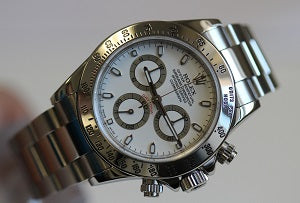History of the Rolex Daytona - King of Rolex Watches
Cosmograph Daytona

The Rolex Cosmograph Daytona is arguably, the most well sought after and stylish watches of the Rolex line. Wear it in any country around the world, and you like likely get quick glances and nods of approval.
The Daytona has reached cult status, commonly featured on the wrists of celebrities (male and female), the wealthy, and racing enthusiasts.
Sports watches and chronographs in particular, are constantly being re-defined and transformed, but the Daytona remains largely aesthetically unchanged, even coming up on its 50th anniversary.
Rolex first introduced their chronograph watches in the 1930's, with a two-pusher design in 1937 containing a Valjoux movement. Our Daytona began to take shape towards its present form in 1949 due to the use of the more recognizable Oyster case and Cosmograh name. Finally, in 1960, Rolex placed the tachymeter scale on the bezel instead of printed on the dial with the Cosmograph 623 where it has remained in its iconic present configuration.
The name "Daytona" wasn't printed on the dial until 1961 with the 6241 models, the name stuck and all Cosmographs were known eventually as the "Daytona", even if the name wasn't there.
The last of the major changes to the manual chronograph was the use of screw-down pushers to activate the chronograph function in the 1970's with the reference 6263. Adding the screw-down pushers created a tighter seal to the case up to 100 meters in depth. Only the Gold and Steel and Gold models had "Chronometer" printed on the dial, the only manual wind models to do so.
A Valjoux movement was used in the early Pre-Daytonas and Daytonas up until 1987 when Rolex switch to the Zenith El Primero – the world's first automatic integrated chronograph movement. Rolex had to redesign the movement to operate on a slower beats per hour to reduce the wear on the movement and remain more reliable. This movement although sourced from Zenith was coined by Rolex as the cal. 4030 and was used in the reference 16520 from 1987 until 2000.
With the release of the new reference 116520, Rolex added a more robust bracelet, clasp, and case to the Daytona and also introduced their first fully patented and in-house built chronograph movement – the cal. 4130. The new movement features Rolex first use of their Parachrom Bleu hairspring. The start, stop, and reset features all became more accurate and the movement became more accurate and lighter over all. The Aesthetics of the watch are remarkable similar to the 16520, with the exception of the placement of the sub-dials and their functions. The seconds function was moved from the 9 o'clock position to the more traditional 6 o'clock position.
Daytona Reference Numbers:
1960 to 1991 - 6239, 6241, 6240, 6262, 6263, 6264, 6265
1991 to 2000 - 16520
2000 to present - 116520
Date of production:
1960 to 1991 with Valjoux movements including the 72B, 722/1, 727
1991 to 2000 with modified Zenith movement
2000 to present (for the current 4130 in-house equipped model)
Movement: 4130
Case: 40mm Triplock
Weight:
SS - 146 grams
WG - 200 grams
WG w/strap - 121 grams
Power Reserve: ~72 hours without chronograph engaged